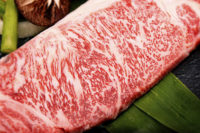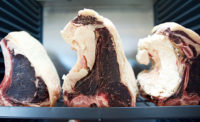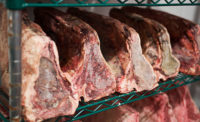It is estimated ground beef accounts for as much as 50 percent of domestic beef consumption. Although the affordability and versatility of ground beef helped establish it as a staple in many American diets, “premium” ground beef blends are now being marketed in several foodservice and retail scenarios, adding value to lower-priced trim components and underutilized whole-muscle cuts. Relative to whole-muscle cuts, dry-aged beef has long been viewed as a high-end product, receiving significant premiums from consumers. Compared to its more commonly utilized wet-aged counterpart, dry-aged beef produces a unique flavor profile by increasing intensities of flavors such as beefy, browned and nutty. Therefore, the objective of this study was to characterize sensory attributes and flavor-related compounds associated with the inclusion of dry-aged beef in ground beef blends.
Three unique ground beef blends were formulated from 60 U.S. Department of Agriculture (USDA) Choice shoulder clods to represent fresh ground beef, dry-aged ground beef and a combination of 50 percent fresh and 50 percent dry-aged ground beef. Shoulder clods used to formulate fresh ground beef were processed after four days of storage in a plastic lined combo. Dry-aged shoulder clods were first wet aged for 21 days in individual vacuum packaged bags, then removed from vacuum bags, placed on stainless steel racks and dry aged for an additional 21 days. The combination blend was formulated using equal weights of fresh and dry-aged shoulder clods. Although total days of aging differed between fresh and dry-aged beef (four days versus 42 days, respectively), the prescribed treatments were applied to reflect common commercial ground beef and dry-aging practices. Because of concerns regarding the growth of spoilage bacteria and decreased shelf life, fresh trimmings or subprimals typically have no more than a few days of age before grinding, packaging and distribution. But extended aging times are necessary for the development of dry-aged sensory attributes and are often achieved using a combination of wet- and dry-aging periods. After blend formulation, ground beef was formed into 1/3-pound patties and frozen until analyses. Sensory profiles were characterized using a trained descriptive sensory panel. Additionally, fatty acids and selected volatile compounds were measured to identify factors influencing flavor differences.
Results of all analyses showed meaningful differences between fresh and dry-aged ground beef blends. Furthermore, there were several instances in which the combination blend produced values that were intermediate to both fresh and dry-aged blends, suggesting the ability to manage the extent of dry-aged beef-related sensory characteristics by controlling its inclusion level. Beefy/brothy and buttery/beef fat flavors did not differ between fresh and dry-aged ground beef. Dry-aged ground beef, however, did produce more intense brown/grilled, earthy/mushroom, nutty/roasted nut, sour/acidic and bitter flavor notes. In fresh patties, earthy/mushroom and nutty/roasted nut flavors were nearly undetectable but became much more prominent as the level of dry-aged ground beef increased. In regard to texture, dry-aged patties were harder and less tender than fresh ground beef. In studies comparing wet- and dry-aged whole-muscle cuts, tenderness is not affected by aging treatment when aging length is held constant. In the current study, dry-aged patties had lower moisture content, which may have contributed to perceived differences in texture attributes.
Changes in fatty acid profiles were measured between fresh and dry-aged patties. Dry-aged patties had greater concentrations of stearic acid, while fresh patties had greater concentrations of shorter saturated fatty acids. Shorter chain fatty acids have less oxidative stability than longer chain fatty acids. Thus, the decrease in shorter chain saturated fatty acids may have been the result of exposure to oxygen during the dry-aging process. Additionally, oleic, palmitoleic and conjugated linoleic acid were found in greater concentrations in fresh patties compared with dry-aged patties. Similarly, unsaturated fatty acids have reduced stability when exposed to oxygen, so differences between treatments may have been caused by the exposure to oxygen.
Of the 40 volatile compounds measured, 12 were affected by ground beef treatment, with 11 of these compounds measured in greater quantities in dry-aged patties. It is evident that the dry-aging process either facilitated the development of several volatile compounds or concentrated flavor compounds due to moisture loss. Because the length of aging was different between fresh and dry-aged beef treatments, caution must be used when attributing differences in flavor compounds specifically to dry-aging or to aging in general. For instance, numerous compounds measured in greater concentrations from dry-aged patties were products of bacterial fermentation or involved the interaction of free amino acids. Both bacterial fermentation and free amino acid content would be expected to increase with increased length of aging, regardless of aging type. Nonetheless, the prescribed dry-aging treatment altered the production of several volatile compounds related to beef flavor. Like fatty acid profiles, several volatile compounds related to lipid oxidation were also extracted in greater amounts from dry-aged patties.
Although the total days of aging was not equal between fresh and dry-aged treatments, the ground beef blends utilized in the current study reflect common commercial practices for producing fresh ground beef and dry-aged beef, respectively. Including dry-aged shoulder clods in ground beef blends increased the intensity of several flavor attributes associated with the dry-aging process, which showed relationships to differences in fatty acid profiles and the production of numerous volatile flavor compounds. Although not all consumers prefer the flavor of dry-aged beef, those who do generally indicate an increased willingness to pay for these types of products. Between the increasing value of ground beef in general and the value associated with dry-aging, marketing dry-aged ground beef blends would provide an avenue for restaurants and retailers to provide a unique “premium” ground beef blend to consumers. NP
Author affiliation: Gredell, McHenry, Woerner, Engle, Tatum and Belk are with the Department of Animal Sciences, Colorado State University. Woerner, Legako and Brooks, are with the Department of Animal and Food Sciences, Texas Tech University



